As the climate crisis intensifies, sustainability is no longer merely a Corporate Social Responsibility (CSR) initiative; it has become a core business priority. Sustainability in telecommunication industry is particularly urgent, as telcos account for up to 3% of total power consumption and contribute significantly to electronic waste. From data centres and mobile infrastructure to supply chains and consumer devices, telcos face increasing pressure to operate more sustainably.
Environmental regulations are tightening, shareholders are demanding transparency, and digital-native consumers expect brands to take the lead on green innovation. In this landscape, eSIM technology is emerging as one of the most impactful tools in the industry’s sustainability arsenal.
TL;DR
- Why is sustainability urgent for telecoms? Energy usage, e-waste, and supply chain emissions are putting pressure on operators to transform. Fast.
- How are plastic SIM cards part of the problem? Traditional SIMs generate e-waste and contribute to carbon emissions through production, packaging, and shipping.
- What role does eSIM play in sustainability? eSIM eliminates plastic waste, reduces logistics, and enables remote provisioning, all while improving CX.
- Can eSIM help my business go green? From operational savings to improved customer retention, eSIM-first telcos gain a competitive edge.
- How do I start with eSIM? Mobilise’s White-Label eSIM App and eSIM SDK are ready-made solutions to embed sustainability into your offering.
What Sustainability Challenges Are Telecom Operators Facing in 2025?
The conversation about sustainability in telecom is intensifying, and for good reason.
e-Waste & Plastic SIM Cards
Traditional SIM cards may be small, but their environmental impact is anything but. Around 4 billion SIM cards were shipped globally in 2023, generating thousands of tonnes of plastic waste and significant emissions from manufacturing and shipping. According to a study conducted by G+D and Fraunhofer IZM, 59% of the emissions associated with traditional SIM cards come from production and 41% account for transport and use. This includes the extraction of raw materials, plastic moulding, chip manufacturing, and global transport, none of which are needed for eSIMs.
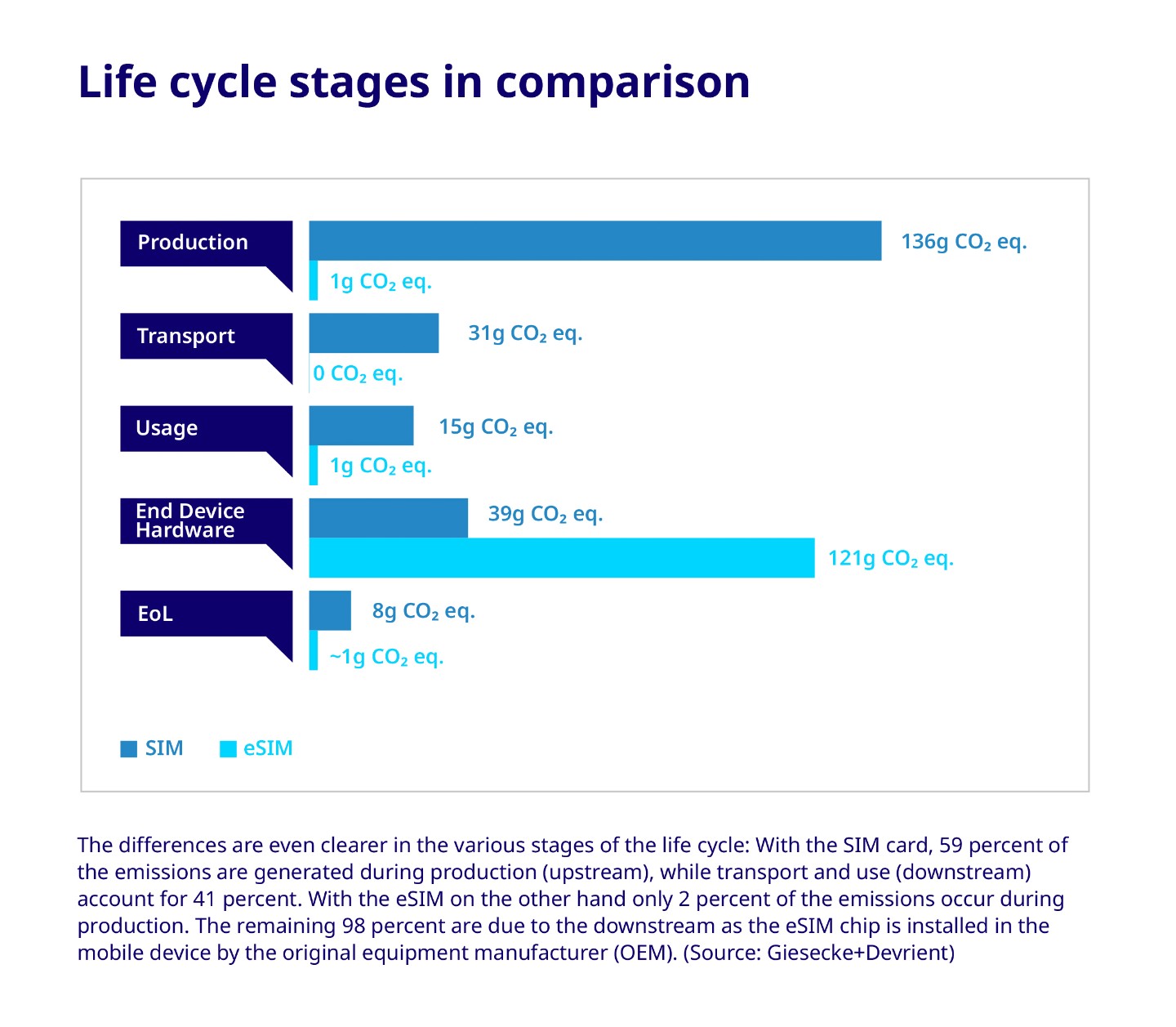 Source: G+D and Fraunhofer IZM
Source: G+D and Fraunhofer IZM
In stark contrast, eSIMs generate 46% lower CO2 emissions compared to plastic SIM cards. Their footprint primarily stems from the computing power and energy required to transmit QR codes during remote provisioning. While detailed carbon accounting for eSIM production is still evolving, the differences are clear: eSIMs are integrated directly into smartphones, eliminating the need for separate manufacturing, shipping, or disposal. There’s no plastic packaging, no oversized SIM holders and no physical waste when a user switches networks.
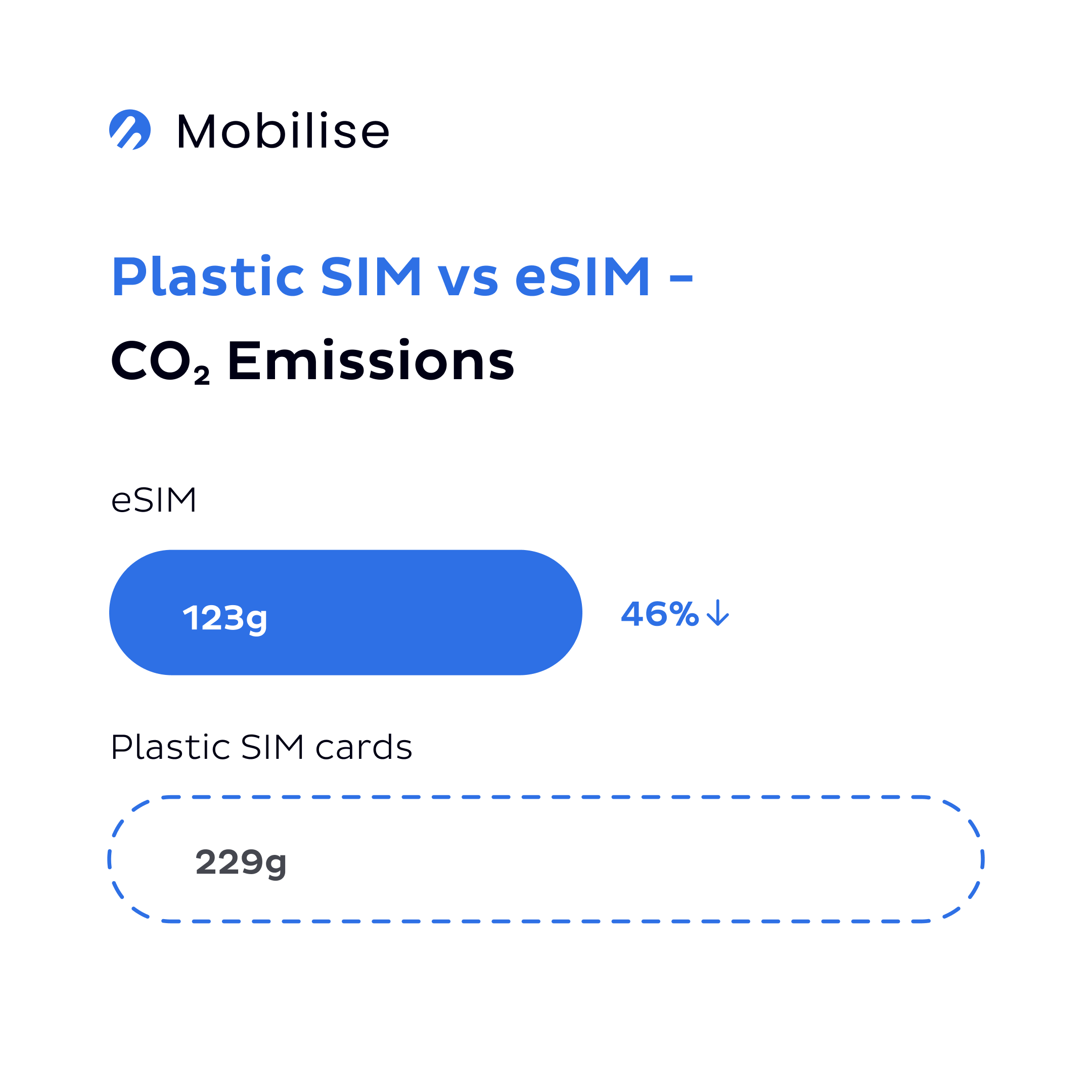
Energy-Intensive Networks
According to the European Commission’s Joint Research Centre, telecom networks are among the top energy consumers globally. In the EU alone, telecom networks consumed an estimated 25-30 terawatt-hours (TWh) of electricity in 2022, representing approximately 1-1.2% of total electricity consumption. Mobile networks accounted for about 60% of this total, with the four most populous EU countries – Germany, France, Italy and Spain – collectively consuming 65% of the region’s telecom energy despite representing just 58% of the population.
With the rollout of 5G and increasing data consumption, this footprint is set to increase massively. In fact, Ericsson reports that 5G mobile subscriptions will reach nearly 5.6 billion in 2029. Although the continued rollout of 5G and the advantages of a more energy-efficient, future-ready infrastructure are clear, they alone aren’t sufficient to significantly cut energy consumption across entire mobile networks to aid sustainability in telecommunication industry.
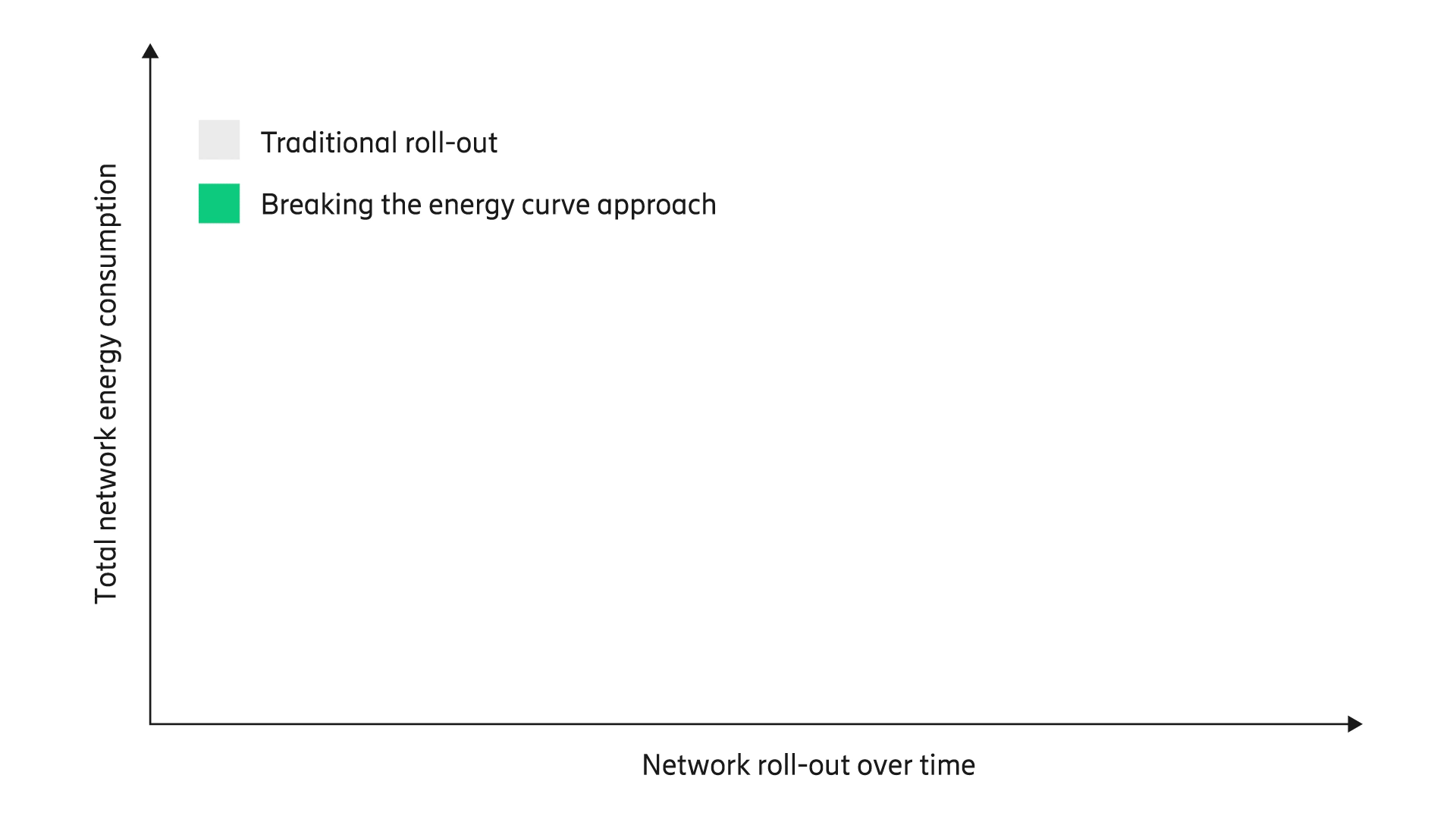 Source: Ericsson
Source: Ericsson
We cannot continue with a ‘business as usual’ approach…. To put it simply, we need to think differently.
Fredrik Jejdling, Executive Vice President and Head of Business Area Networks, Ericsson.
Supply Chain & Logistics Emissions
As telecom operators race to reduce their direct emissions, a challenge remains – the supply chain. According to S&P Global, 72.2% of emissions from the European telecom sector come from Scope 3 emissions, which originate across the value chain, from manufacturing to customer usage. More recently, ABI Research found that Scope 3 emissions are projected to rise from 746 million tons of CO2e in 2024 to 891 million tons by 2030, growing at a Compound Annual Growth Rate (CAGR) of 2.99%.
In 2020, those Scope 3 emissions reached a staggering 36.6 million tonnes of CO2 equivalent, compared to just 1.6 million tonnes from direct operations. Giants like Deutsche Telekom, Vodafone, Orange, and Telefónica lead the list simply due to their scale. But size alone doesn’t explain the complexity. Not only are Scope 3 emissions typically the largest source, it’s also notoriously difficult to track and reduce.
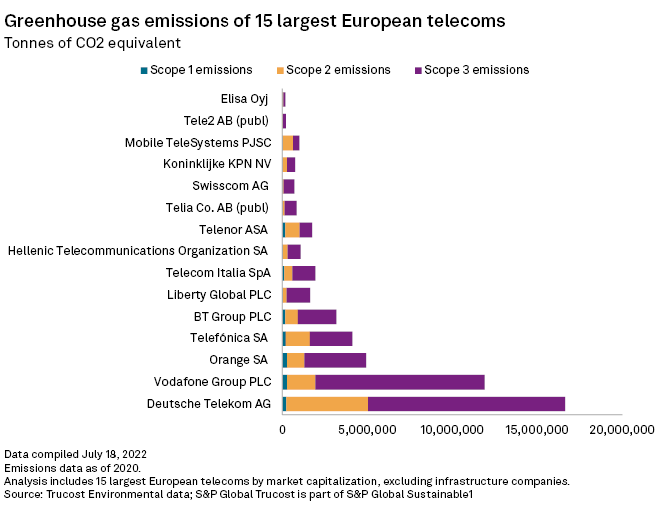 Source: S&P Global
Source: S&P Global
A major culprit is the logistics footprint of traditional SIM cards. From manufacturing to packaging and international distribution, each plastic SIM contributes to an extensive web of emissions. With multiple suppliers, long transportation routes, and short product lifespans, physical SIMs represent an outdated model in a world striving for sustainability.
Ultimately, the environmental cost of physical telecom infrastructure, especially when it comes to SIM production and delivery, can no longer be ignored. The shift to digital-first solutions like eSIM, which eliminates the need for physical logistics altogether, is a practical and powerful step in mitigating Scope 3 emissions while moving closer to net-zero ambitions.
Customer Behaviour & Expectations on Sustainability in Telecommunication Industry
Sustainability is now at the heart of modern digital telecom consumers’ expectations, especially among Millennials and Gen Z. Often dubbed “The Sustainability Generation,” these demographics are redefining how brands are perceived and chosen. According to Deloitte, climate change is a top stressor for both groups, with 73% of millennials and 69% of Gen Zs actively trying to reduce their environmental impact in daily life.
This shift in values has a direct impact on purchasing behaviour. Around 60% of Gen Z and millennial consumers are willing to pay more for sustainable products and services. However, economic pressure is a limiting factor. Over half believe it may become harder or impossible to make eco-conscious choices unless those options become more affordable. This puts pressure on businesses, to offer sustainability in telecommunication industry, without the premium price tag.
About 80% of these consumers also expect companies to do more. Whether it’s through greener packaging, cleaner supply chains, or more transparent environmental claims. Trust matters: nearly one in three consumers already evaluate sustainability certifications and corporate claims before making a purchase, and another third plan to do the same. Greenwashing practices aren’t enough.
According to PwC, 43% of consumers surveyed report making more considered purchases to reduce their overall consumption. And, on average, consumers are willing to pay up to 9.7% above the average price of a product that is more sustainable.
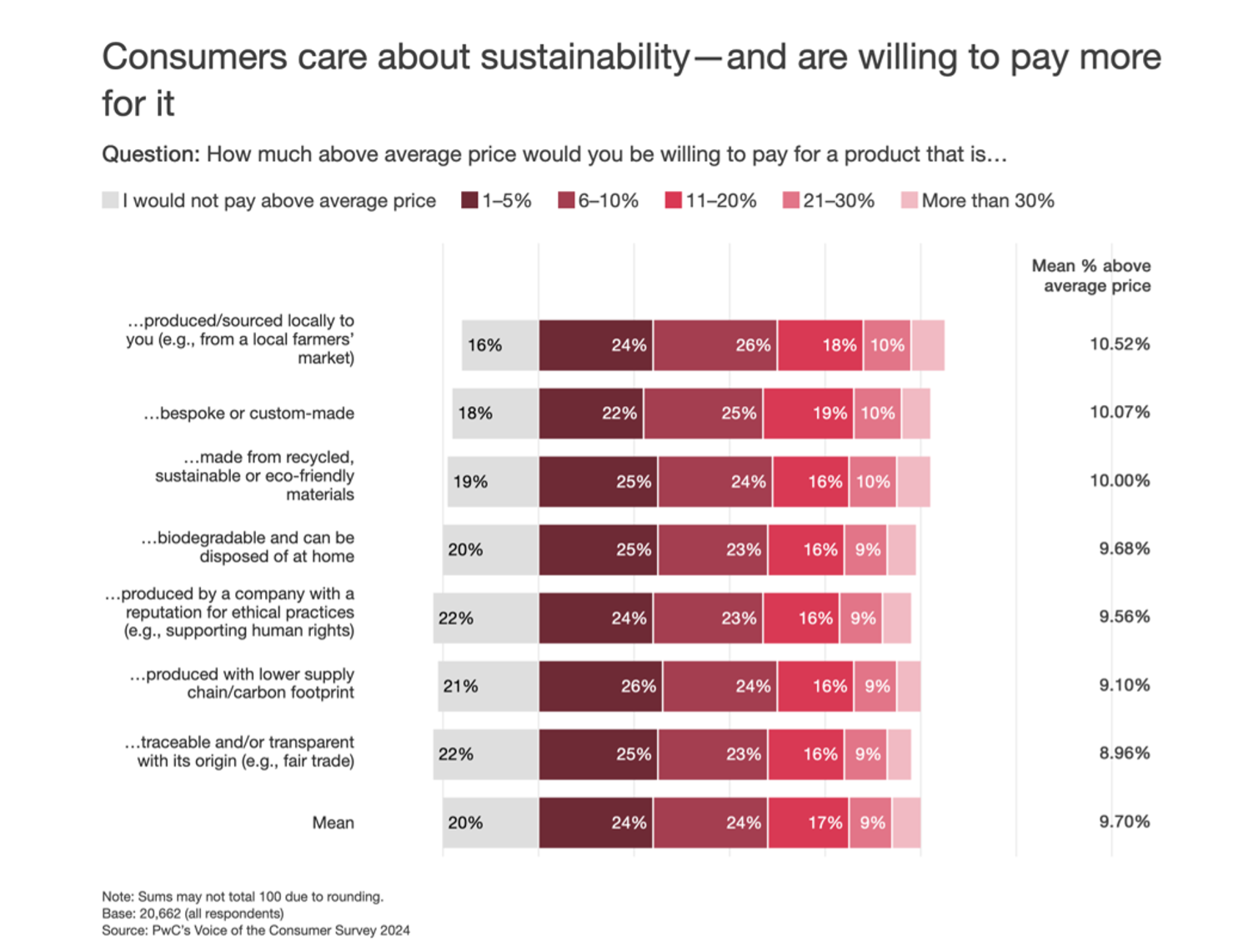 Source: PwC
Source: PwC
This is where telecom operators have a unique opportunity to lead by example. Embracing digital-first technologies like eSIM, reducing waste, and committing to long-term net-zero targets are essential steps. But beyond that, operators must also consider how they contribute to a circular economy in telecom, designing services and products that maximise reuse, minimise waste, and extend device lifecycles. From the benefits of Embedded Connectivity that reduces the need for physical SIM cards to infrastructure that supports device recycling and repair, telcos can become enablers of more sustainable digital lifestyles.
For consumers increasingly aligning their wallets with their values, brands that embed sustainability, not just market it, will win long-term customer loyalty in telecom.
Done right, sustainability doesn't cost. It pays.
Ray Anderson, CEO of Interface.
How Does eSIM Support Sustainability in Telecommunication Industry Goals?
As telecom operators face mounting pressure to decarbonise operations and embrace more sustainable business models, eSIM stands out as a critical enabler of environmental progress. Beyond convenience and flexibility, eSIM represents a shift toward digital-first infrastructure that reduces waste, lowers emissions, and aligns with circular economy principles.
Traditional SIM cards contribute significantly to e-waste and plastic pollution, with billions produced and shipped each year. Each card typically comes enclosed in a plastic holder, often up to eight times larger than the SIM itself and is transported through carbon-intensive logistics networks. In contrast, eSIMs eliminate the need for plastic altogether, offering a fully digital alternative that reduces packaging waste and eliminates physical distribution.
The environmental benefits of eSIM are quantifiable. While traditional SIM cards generate around 60% of their total emissions during production and distribution, eSIMs generate 46% less carbon emissions, which are mainly due to the minimal energy required for QR code generation and transmission. Since eSIMs are soldered directly into devices during manufacturing, they avoid separate transport and disposal, supporting a more streamlined and sustainable value chain.
Supporting the Circular Economy
eSIM also enables longer device lifecycles by eliminating the need for physical SIM swaps, particularly in IoT, enterprise, and Embedded Connectivity scenarios. Devices can be reconfigured or repurposed without physical intervention, reducing unnecessary hardware replacement and encouraging reuse over replacement, a foundational principle of the circular economy in telecom.
Enabling Greener MVNOs and Digital-First Operators
For emerging MVNOs and digital-first operators, eSIM unlocks the ability to launch and scale services without physical infrastructure. There’s no need for printed contracts, plastic inventory, or brick-and-mortar distribution. This digital-native approach not only cuts emissions and costs but also meets rising consumer demand for eco-conscious telecom solutions with an entirely digital customer journey, especially among Gen Z and millennial audiences.
Sustainability doesn’t need to sacrifice user experience. In fact, eSIM improves it, allowing customers to activate and manage connectivity instantly from their device without delays or manual intervention. For climate-conscious consumers, this is a win-win: a better user journey with a lower environmental footprint.
In essence, eSIM isn’t just a technology upgrade. It’s a pathway to a more sustainable, efficient, and customer-centric telecom future.
How Do Mobilise’s eSIM Solutions Enable Sustainable Telecom Transformation?
White-Label eSIM App: Enabling a Seamless, Digital-Only Experience
Mobilise’s White-Label eSIM App provides a fully branded platform where users can download, activate, and manage their mobile connectivity completely digitally. No plastic. No shipping. No in-store visit.
The app streamlines digital onboarding, reducing reliance on printed contracts or physical identity verification. This supports sustainability and enhances the customer experience, which is crucial for improving customer loyalty in telecom.
For operators, this means fewer operational costs, stronger compliance with ESG goals, and a differentiated position in the market. And thanks to in-app eSIM provisioning, the footprint is even lower. eSIMs generate 46% less carbon emissions, which are mainly due to the minimal energy required for QR code generation and transmission
FIND OUT MORE
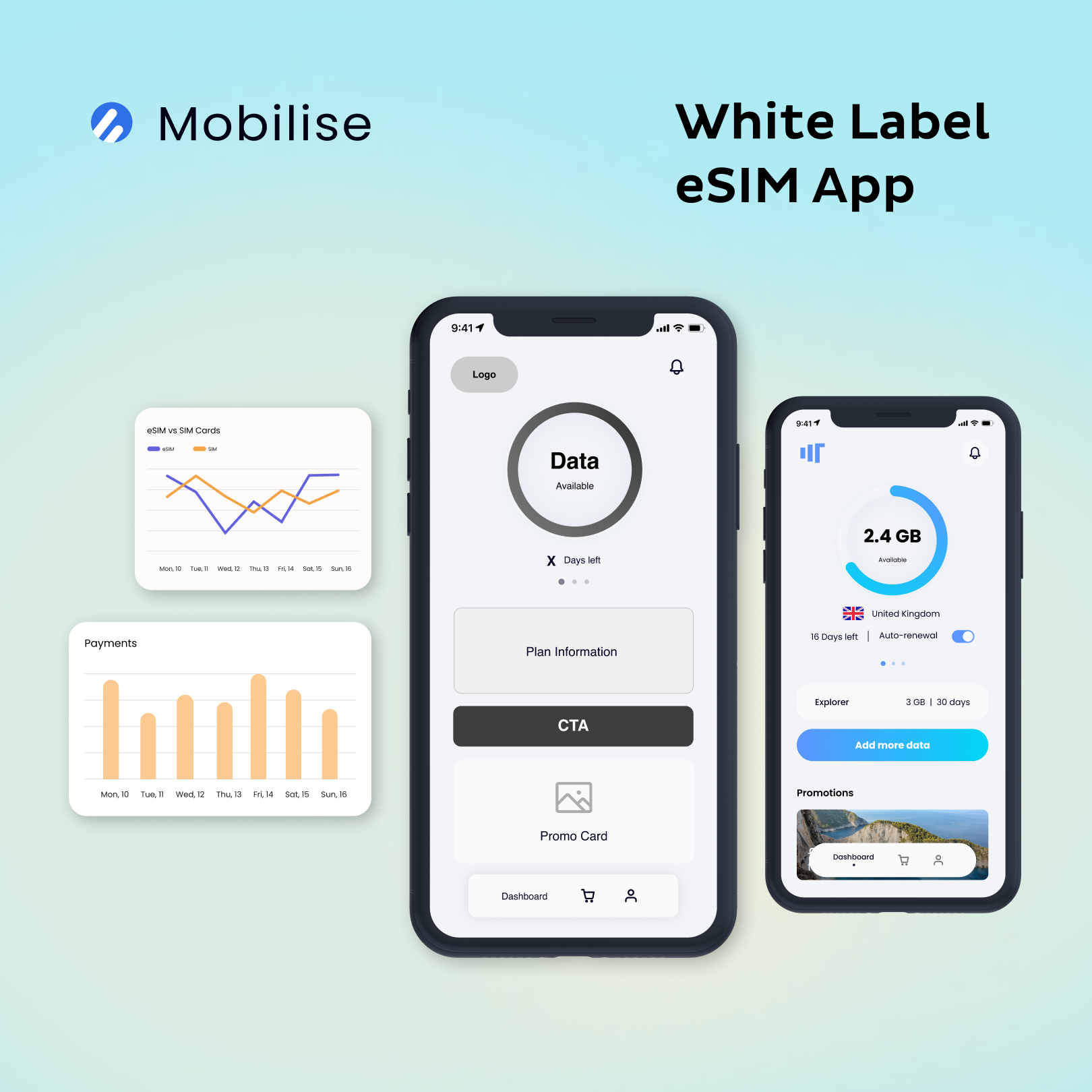
eSIM SDK: Embedding Sustainability into Any Mobile App
Mobilise’s eSIM SDK allows telcos, MVNOs, and OEMs to integrate eSIM activation into existing apps. Whether it’s a travel brand, an IoT provider, or an enterprise mobility platform, the SDK makes eSIM available where users already are, minimising the environmental impact of logistics and packaging.
This technology is already transforming industries with built-in sustainability advantages. From reducing paper trails in enterprise solutions to improving the travel experience with eSIM as a value-added service, the SDK is a flexible, future-proof tool.
FIND OUT MORE
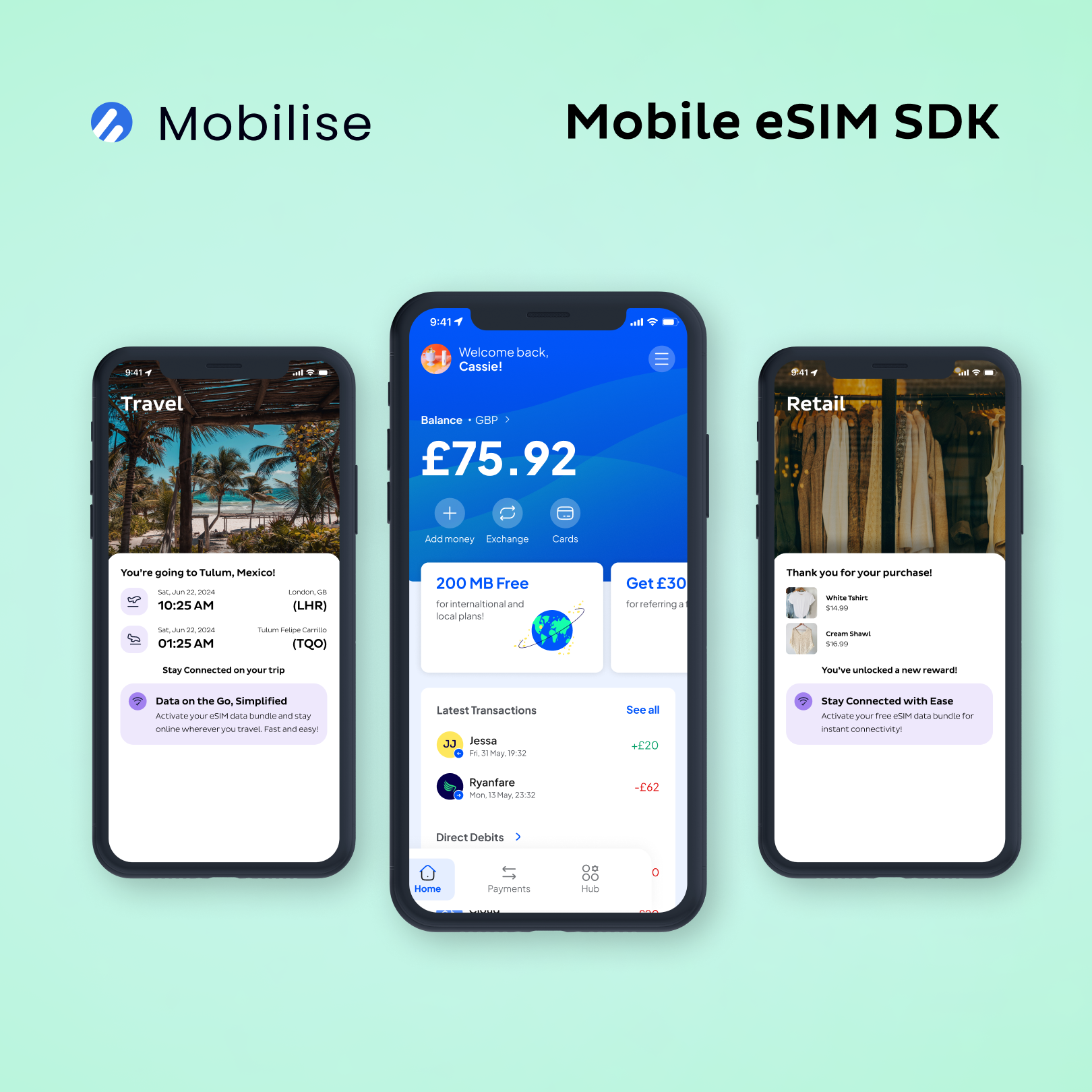
What’s The Business Case for Sustainability in Telecommunication Industry?
Sustainability is no longer a moral obligation; it’s a strategic imperative for telecom operators seeking long-term growth, risk mitigation, and competitive differentiation. The case for greener practices in telecom goes far beyond environmental stewardship.
Regulatory Compliance
With the European Green Deal and Net Zero Coalition in place and the rise of ESG (Environmental, social and governance) reporting requirements, compliance is no longer optional. Such frameworks and governing bodies are pushing large companies, including telcos, to disclose and reduce their environmental impact.
Operators must also consider country-specific regulations around energy efficiency, waste management and emissions reporting. Compliance is not only essential to avoid penalties but also to qualify for public tenders, spectrum licenses, and green funding opportunities.
Cost Savings
Sustainable telecom operations are often more efficient operations. Migrating from traditional SIM cards to eSIM significantly reduces costs across physical production, packaging, distribution, and inventory management. The overhead involved in logistics, warehousing, and retail is replaced by instant remote SIM provisioning, which can reduce both OpEx and CapEx.
Energy efficiency measures, like optimising network performance with AI, consolidating infrastructure, or using renewable energy, also yield direct financial benefits. According to GSMA, energy consumption constitutes between 20 – 40% of total network OpEx in some markets, meaning reductions here can deliver substantial bottom-line improvements.
Customer Loyalty & Competitive Advantage
Green practices are proven drivers of customer retention in telecom. Gen Z and millennial consumers, now dominant user segments, are willing to pay more for sustainable services and more likely to stay loyal to brands that reflect their values. As consumers seek out brands that align with their values, sustainability can be the key differentiator in a crowded market.
Operators that lead on sustainability in telecommunication industry are also better positioned to retain enterprise clients who are under pressure to transform their own supply chains and incorporate greener practices. For example, companies adopting Science-Based Targets (SBTs) must ensure their suppliers, including connectivity providers, align with emissions goals. A sustainability-first telecom partner becomes a strategic asset.
Brand Reputation
Brands that lead on sustainability in telecommunication industry are seen as innovators. A reputation for environmental responsibility drives long-term brand equity. According to PwC, consumers are willing to pay 9.56% more for a product that has a reputation for ethical practices.
Perception matters, and sustainability shapes it. Consumers, investors, and partners are all paying attention to ESG credentials. A clear, credible sustainability strategy strengthens a brand’s public image, investor confidence, and media positioning.
Operators who fail to act face increasing reputational risk, especially as consumers become more adept at spotting greenwashing. On the other hand, those who back up their sustainability claims with transparent reporting and meaningful action can stand out as industry leaders.
How to Get Started with eSIM for Sustainability in Telecommunication Industry
- Assess your current sustainability impact.
Start with a carbon footprint analysis. Identify where emissions and waste are generated across your operations, from manufacturing to customer onboarding. - Adopt a digital-first approach.
Ditch the plastic and go digital. eSIM onboarding not only reduces emissions but enhances UX. - Partner with the right eSIM provider.
Mobilise offers scalable, flexible, and sustainability-first solutions to help you transition seamlessly.
It’s clear, now more than ever, that telcos must make a change. Sustainability in telecommunication industry is no longer a side initiative; it’s a powerful business driver. And implementing eSIM is a great step towards lowering your carbon footprint. It delivers resilience, profitability, customer trust, and alignment with global transformation trends. Going green isn’t just good for the planet – it’s great for business.
Explore how Mobilise’s White-Label eSIM App and eSIM SDK can help hit your sustainability goals while improving customer experience!



